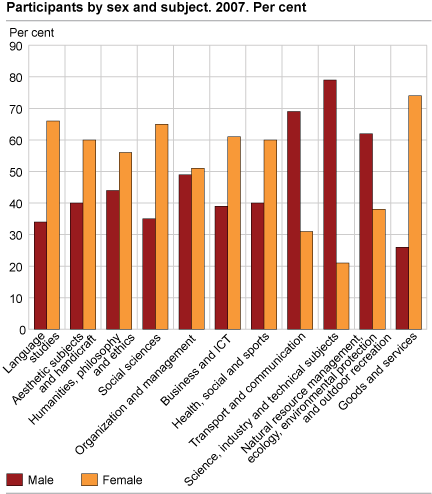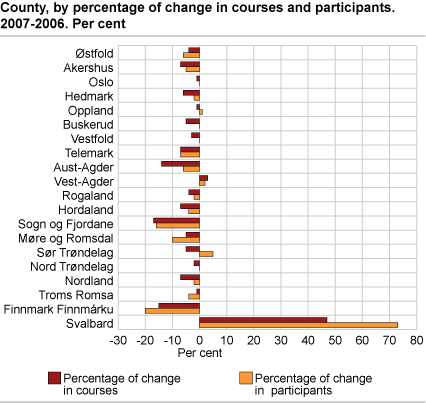Content
Published:
This is an archived release.
37 000 courses with 490 000 participants
The popular education organisations arranged 37 000 courses with 490 000 participants and 1 315 000 lessons during 2007. Compared to the previous year, there were 2 000 fewer courses, 16 000 fewer participants and 84 000 fewer lessons in 2007.
From 1997 to 2007 the number of participants in the courses organised by popular education organisations decreased by 31 per cent, and the number of courses decreased by 42 per cent.
Highest decline in Finnmark
Finnmark county had the highest decline in number of participants, while Sogn og Fjordane county had the highest decline in number of courses during 2007 compared with 2006. Finnmark had a 20 per cent decrease in participants, while the number of courses decreased by 17 per cent in Sogn og Fjordane.
Vest-Agder county was the only county with both a higher number of courses and a higher number of participants during 2007. Compared to the previous year, the number of participants increased by 2 per cent, and the number of courses increased by 3 per cent.
212 500 participants chose aesthetic subjects and handicraft
The participation on different courses varied a lot, depending on subject. Like previous years, aesthetic and handicraft courses were the most popular ones. The popular education organisations arranged 15 600 courses with 212 500 participants within aesthetic subjects and handicraft during 2007. At the other end, 280 courses with 2 800 participants were arranged within goods and services subjects.
Female participants were in majority in most main subjects. Courses with high female percentages were goods and services (74 per cent), languages (66 per cent) and social sciences (65 per cent). On the other hand, men accounted for 79 per cent of all participants within science, industry and technical subjects.
Tables:
- Table 1 Number of courses, participants and lessons by organization. 2000-2007
- Table 2 Number of courses, participants and lessons by county. 2000-2007
- Table 3 Number of courses, participants and lessons by subject. 2000-2007
- Table 4 Number of participant by age, sex and county. 2000-2007
- Table 5 Number of partocipant by age, sex and subject. 2007
- Table 6 Number of participants by subject and county. 2000-2007
Contact
-
Hossein Moafi
E-mail: hossein.moafi@ssb.no
tel.: (+47) 90 40 31 19


